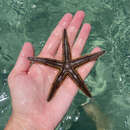en
names in breadcrumbs


Astropecten duplicatus, the two-spined sea star, is a starfish in the family Astropectinidae. It is found in the eastern Atlantic Ocean, the Caribbean Sea and the Gulf of Mexico.
Astropecten duplicatus normally has five long slender, tapering arms which are flattened dorso-ventrally. The aboral (upper) surface has a single row of large marginal plates around the edges of the arms. These are granular, and the two that are closest to the disc each bear a conical spine, although this is often worn away. Other marginal plates and the plates on the oral (lower) surface bear many fine blunt spinules. The tube feet are pointed and have no suckers. Astropecten duplicatus grows to about 20 cm (8 in) in diameter. The aboral surface is pale grey or reddish-brown and the oral surface is pale brown or orange.[2][3]
Astropecten duplicatus is native to the eastern Atlantic Ocean, the Caribbean Sea and the Gulf of Mexico. Its range extends from Cape Hatteras, Florida, Cuba and the Bahamas to Mexico, Colombia, Venezuela and Guyana.[1] It is found on sand or other soft sediments and in seagrass meadows at depths down to about 500 metres (1,600 ft).[2]
Astropecten duplicatus spends the day semi-immersed in the sediment on the seabed. It is a carnivore and at night it hunts for bivalve molluscs and gastropods. It transfers its prey to its mouth with its arms, and swallows it whole, later regurgitating any undigested fragments.[4]
Astropecten duplicatus, the two-spined sea star, is a starfish in the family Astropectinidae. It is found in the eastern Atlantic Ocean, the Caribbean Sea and the Gulf of Mexico.